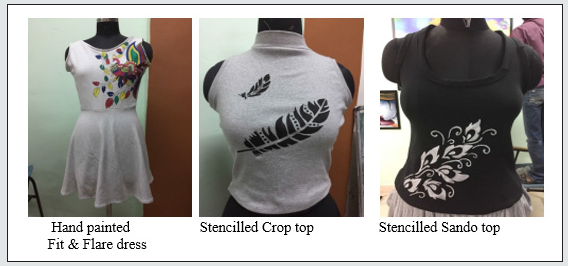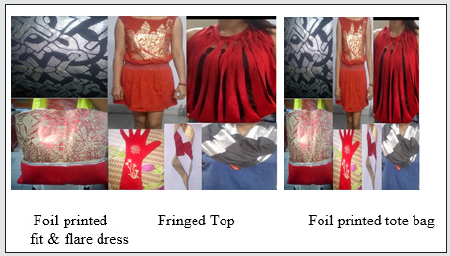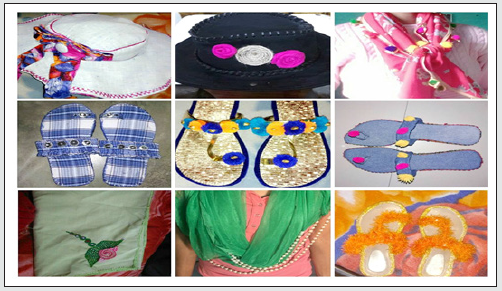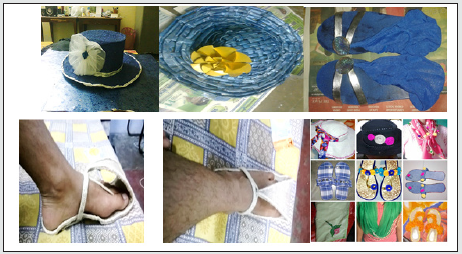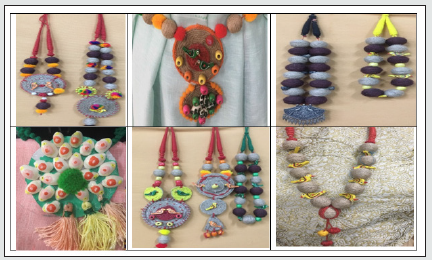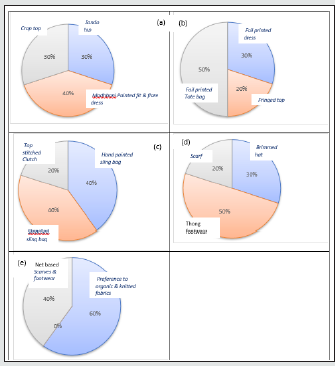
Lupine Publishers Group
Lupine Publishers
Menu
ISSN: 2637-4595
Research Article(ISSN: 2637-4595) 
Design & Development of Traditional & Sustainable Contemporary Women Wear Volume 4 - Issue 2
Y Jhanji*
- Department of Fashion & Apparel Engineering, The Technological Institute of Textiles & Sciences, India
Received:July 05, 2021 Published: July 13, 2021
*Corresponding author: Y Jhanji, Department of Fashion & Apparel Engineering, The Technological Institute of Textiles & Sciences, India
DOI: 10.32474/LTTFD.2021.04.000183
Abstract
The textile and garment industry in spite of its contribution to country’s GDP and employment avenues is also responsible for environmental pollution owing to hazardous effluents, landfills and wasteful practices in textile supply chain. The need of the hour is thus switching over to conventional manufacturing processes, use of organic fibres, natural dyestuff, adoption of sustainable principles and approaches like upcycling and recycling at each manufacturing process to avert any deleterious environmental impacts. Furthermore, there is an ardent need of giving impetus to indigenous traditional textiles and crafts so that the rich legacy of traditional textiles and fine workmanship is not merely restricted to means of livelihood for skilled artisans. The fashion designers in the pursuit to revive traditional textiles and to support artisans have been working in close association with artisans and switching over to sustainable raw material procurement and manufacturing practises. Accordingly, designers have been utilizing recycled, upcycled materials, sustainable fibres in their collection and garnering inspiration from the lively, mythological and colourful motifs of these beautiful art forms to design and develop a gamut of high-end artifacts, apparels, home textiles and accessories with amalgamation of traditional and contemporary look in design collection. The present study was therefore undertaken to identify the preferential traditional techniques along with consumer acceptability for recycled and upcycled apparels and accessories. The design collection comprised of varied styles of eco-friendly, sustainable apparels and accessories like fit and flare dress, crop top, sando top, handbags, fashion jewelry, hats, scarves and footwear utilizing surplus, unsold fabrics of short yardage collected from local fabric vendors and encouraging female faculty and students of nearby regions to drop their unused clothing and accessories in drop boxes for collectibles positioned outside the institute. The design collection was intended for female millennials who prefer a casual look in office wear, seeking traditional appeal with a modern twist but shy away due to exorbitant prices of authentic handcrafted pieces of workmanship. The clothing was designed taking inspiration from structured and unstructured interview schedules, field visits to local markets selling traditional textiles and promotional hubs for artisans works like Suraj Kund Crafts Mela, Hunar Hatt, Delhi Hatt. The cost evaluation of designed end products revealed that the production cost was quite low as all the raw materials ranging from fabrics to trims and notions were upcycled and recycled.
Keywords: Artisans; contemporary craft; eco-friendly; sustainable; hand painting; madhubani; motifs; revival; stencils; traditional
Introduction
India presents a classic example of university in diversity with enormous diversity in dialect, lifestyle, traditional art, craft and folk culture of different states. A myriad of traditional techniques namely hand painting, dyeing and printing techniques are extensively utilized for surface ornamentation of textiles. The techniques are specific to particular region of country and accomplished by artisans as part of their rich legacy and also as a means of livelihood. Per se the designers have been working in close association with artisans not just to augment their earnings but also to come up with design collections intended for the consumers deeply connected to roots and having penchant for hand crafted, traditional artifacts. Furthermore, designers prefer several indigenous surface ornamentation techniques like traditional painting, embroidery, dyeing and printing for aesthetic appreciation of their design collection and thus value for money to the loyal consumers. The unique and intricate workmanship of artisans serve as an inspirational source for designers who incorporate the design elements such as traditional motifs and colors in their creations. The design inspiration is drawn from the vibrant color hues and lively, mythological and colourful motifs of these beautiful art forms for design and development of a gamut of high-end artifacts, apparels, home textiles and accessories using a range of textile raw materials. Most of the traditional techniques are performed on handloom fabrics; however, a range of raw materials can be experimented with to bring out the magnificence of traditional art forms on textiles. Traditional textiles namely Madhubani, Ikat, Kalamkari, Patola, Ajrakh find application in designing female traditional and contemporary apparels and accessories [1-3].
Knitted fabrics are increasingly being utilized for designing sportswear, athleisure and women casualwear owing to their stretch, comfort and easy-care properties. A wide range of female wear namely shift dress, sheath dress, slip dress, a line dress, flared dress, crop skirt, pencil skirt, palazzo trousers, palazzo pants/ jeggings, layered palazzos, trouser style palazzos, pleated palazzos and side slit palazzo. Apart from apparels, knit structures are also increasingly utilized for designing accessories like handbags, hats, scarves and knitted jewelry like earrings, neck pieces and hair accessories [4-6]. Apparel and accessory surface ornamentation involving designing the outer surface to render it beautiful and attractive appeal results in enhancement of aesthetic appeal and value addition. The commonly used surface ornamentation techniques for clothing and fashion accessories involve embroidery, beading, ribbon embroidery, hand painting, macrame, applique, crocheting, resist dyeing and block printing. Sustainable fashion is the need of the hour considering the adoption of fast fashion concept by leading apparel and accessory brands, surplus garment production, repetitive sampling, order rejection and customer returns lying unattended in warehouses are major contributors to landfills and hence carbon emissions. The utilization of ecofriendly, non-hazardous resources at each process and due consideration to environmental and social aspects encompasses the sustainable principles in textile and fashion supply chain [7,8]. The sustainability attributes need to be stringently followed right from raw material procurement to finishing, processing and finally packing and shipment to retail outlets.
The utilization of eco- friendly materials such as bamboo, hemp, organic cotton, employing energy and water efficient processes for dyes and finishes and replacing chemical dyes with natural or organic dyes are some sustainable approaches being practiced by textile and fashion manufacturers. Another innovative sustainable approach employed involves designing for dis-assembly and with no waste to reintroduce the torn, disposed garments into garment life cycle. Additionally, the burden on textile and fashion supply chain on environment can be annulled by reusing, re-assembling, up-cycling, utilization of biodegradable products, vintage and heirloom collection. The present study was therefore undertaken to identify the preferential traditional techniques along with consumer acceptability for recycled and upcycled apparels and accessories. The market survey and field visits to local markets highlighted that although there is gamut of madhubani painted, foil printed and shibori dyed woven and handloom ethnic wear available in various price points. However, there was dearth of eco-friendly, contemporary and customized range of knitted apparels and accessories embellished with surface ornamentation techniques. The present study therefore aims to address this pitfall and identify the preferential traditional techniques, styles and silhouettes which entice consumers and thus designing cost effective, contemporary apparel and accessory styles experimenting with base fabric and replacing handloom with knitted fabrics as the latter ensues comfort, dexterity, stretch ability and can be easily converted into complex silhouettes. The target consumer group for the study was female millennials who prefer a casual look in office wear, seeking traditional appeal with a modern twist but shy away due to exorbitant prices of authentic handcrafted pieces of workmanship.
Materials
Cotton knitted fabrics in three different structures namely single jersey, rib and interlock were procured from Richa global, Gurugram. The fasteners such as zippers, velcro, magnetic closures, chain links and other essential supplies used for clothing construction and embellishment namely sewing thread and acrylic colors were procured from local market in Bhiwani. The customized stencils were prepared by free hand sketching on cardboard and cutting along edges of required motifs. A range of other surplus, unsold fabrics of short yardage such as denim, canvas, burlap, jute and net fabrics were collected from local fabric vendors. The unused, disposed garments with the purpose of upcycling and recycling were collected by encouraging volunteer female millennials to drop unused clothing and accessories in drop boxes for collectibles positioned outside the institute. Majority of fabrics and garments chosen for the study were solid colors or monochromes to highlight surface embellishment on fabric’s surface. The upcycled fasteners such as zippers, velcro, magnetic closures, artificial flowers, twine, ribbons and chain links were used as decorative and functional components on the end articles.
Design initiation & conceptualization
The protocol of structured and unstructured interview schedules was followed to garner the trending and likeable design and styles elements by consumers such as colors, prints, motifs, fit and embellishment techniques. The styles of upper and lower torso garments to be designed were chosen based on expert ratings and subjective evaluation by respondents. The target respondents were female millennials who prefer casual, quirky and contemporary look in their ensembles. The respondents were females aged 25- 35 years. The experts were free-lancing designers and faculty of Fashion Institutes in Delhi and Haryana. The responses by the respondents assisted in style selection of apparels and accessories namely cold shoulder, crop top, tank top and fit and flare dress, jeggings, harem pants, skirts, handbags, hats and eco-friendly, quirky jewelry. The design process initiated with hand drawn flat sketches for styles approved by expert panel and respondents.
Pattern making & assembling
The two-dimensional pattern making technique of drafting was utilized to prepare the patterns for each individual garment style using the standard size charts for aforesaid age groups. The sewing of garments was accomplished on Juki’s single needle lock stitch machine; model DU-1181N with maximum sewing speed of 2,000sti/min, SPI of 12. Class 4 flat seam was used for assembling the garment components.
Surface embellishment techniques
A variety of traditional and advanced surface embellishment techniques like top stitching, hand painting, stencilling, addition of tassels, pompom, decorative buttons, simulated stones and pearls along with hand embroidery, foil printing and braiding were utilized to design a range of apparels and accessories.
Motif selection
The motifs for surface ornamentation were chosen after exploratory studies of motifs extensively utilized in home decor, stoles, dupattas and sarees showcased in runways and other virtual platforms selling traditional textiles. Therefore, the flora and faunabased motifs were selected for the present study.
Results & Discussion
The knitted fabrics owing to good drapability properties were used for construction of upper and lower torso garments. Fit and flare dress, tank top, skirt, glove and scarves were designed with knitted fabrics while denim fabrics owing to high bending stiffness and durability were utilized for hat construction. The subjective evaluation by respondents provided a foundation for selection of design elements, stylization, embellishment, upcycling and recycling techniques for the design collection. Accordingly, based on respondent’s responses, the chosen styles for design collection comprised of jeggings and harem pants, fit and flare dress, crop top, sando top, cold shoulder top. Likewise, the accessory styles chosen for the design collection included sling bag, clutch, tote, footwear, scarves, gloves and brimmed hat. Hand painting, stencilling and foil printing as a means of aesthetic appreciation of apparels and accessories were given precedence by respondents. Thus, the aforesaid apparel and accessory embellishment techniques were chosen based on subjective trials and respondent ratings to render traditional yet contemporary appeal to the sustainable design collection.
The results and analysis of objective and subjective evaluation were used to design “Sustainable Fusion wear” design collection symbolizing the fusion of traditional and contemporary features in female wear. Figure 1 showcases the Madhubani hand painted embellished fit and flare dress and stencilled crop and sando tops. Foil printed dress and tote bag designed from organic cotton knitted fabric are shown in Figure 2. The design collection also constituted of functional and decorative accessories such as hand painted and top stitched sling bag, clutch and fashion jewelry as shown in Figures 3 & 4. The edge neatening and surface ornamentation of design collection was ensued by attachment of trims and notions. The amputated trims and notions like pompom, tassels, twines, cords, simulated stones, burlap and artificial flowers from discarded garments collected from drop boxes were refurbished to render colorful, quirky, casual appeal to designed accessories like thongs, cowboy hats and scarves (Figure 4). The waste net, denim and jute fabric were beautifully transformed into sustainable accessories like slip on footwear, Kolhapuri chappal, scarf cum neckpiece and brimmed hats as presented in Figure 5. The quirky fashion jewellery was designed using burlap, twine, beads and several other colourful trims as shown in Figure 6. The design collection was evaluated subjectively and through wear trials to rate the design collection based on functionality, aesthetic appeal, and economic consideration. Figure 7 (a-e) shows the results of subjective evaluation of design collection by respondents. Madhubani painted fit and flare dress was the most preferred ethnic wear with 40% respondents voting for the mentioned dress style while crop top and sando top each were preferred by 30% females. 50% female respondents preferred foil printed tote handbag as they considered the handbag trendy and perfect match with fusion wear. 30% respondents had soft corner for foil printed embellished one-piece red dress while fringed top was preferred by just 20% females. The styles of handbags evaluated subjectively highlighted that respondent gave precedence to sling bag style irrespective of embellishment technique and both hand painted, and stencilled handbags were each preferred by 40% respondents while 20% respondents liked tasselled and top stitched clutch as they found it handier and more compact. As far as subjective evaluation of accessories embellished with upcycled decorative components was concerned, 50% female respondents gave precedence to thong footwear which they considered ideal blend of functionality and aesthetics.
Cowboy hat embellished with quirky, vibrant flowers was relished by 30% females who suggested they would love complimenting a bodycon or shirt dress with the quirky hat. Although, the percentage of respondents (20%) preferring edge neatened printed scarf was lower compared to other accessories however, females appreciated the color, embellishment and tying style of the scarf. The sustainable accessories designed with denim, jute and net fabrics garnered mixed responses with 60% females preferred knitted fabrics and organic cotton for summer wear attire as they considered denim hats and jute footwear uncomfortable as summer wear. 40% females like the concept of using net fabric for footwear and scarf designing. The scarf cum neckpiece was the personal favorite of female respondents. Moreover, 60% female respondents preferred hand curated jute neckpieces over tasseled and stone embedded jewelry. Consequently, the most preferred contemporary apparel and accessory style among female millennials based on subjective evaluation was fit and flare dress along with sling bag both embellished with Mahbubani inspired hand painted motifs. The design collection was appreciated for the sustainable approach adopted in designing each entity and the respondents marked their acceptance by expressing wiliness to purchase the attire. The feedback and wear trial by respondents suggested that the design collection was comfortable, stretchable aesthetically appealing and last but not the least eco-friendly [9].
Conclusions
The present study was undertaken to identify the preferential fabric types, surface embellishment techniques, styles and consumer acceptability towards sustainable apparel and accessory design. The target consumer group was female millennials who prefer to titivate casual fusion wear and have penchant for ecofriendly, functional and aesthetically appealing wardrobe in their closet. The designed collection named “Sustainable Fusion wear” symbolizing the fusion of traditional and contemporary features in female wear was developed based on structured and unstructured interviews, expert reviews, wear trials and subjective evaluation. Varying surface ornamentation techniques namely hand painting, stencilling, foil printing and embellishment by trims and notions attachment were employed for value addition and rendering ornate look to the design collection. The most preferred contemporary style among female millennials based on subjective evaluation was hand painted sling bag complimenting fit and flare knitted dress. Furthermore, the subjects expressed liking for quirky and funky hand curated jewellery designed with burlap, jute and a range of colourful trimmings. It was inferred from subjective evaluation that young women generally prefer knitted fabrics and organic materials over denim, jute and sheer fabrics for their attires. Consequently, it can be recapitulated that today’s fashion-conscious females seeks ethnic and quirky look with minimal attachments, particularly having a soft corner for functional, comfortable, eco-friendly yet trendy, dapper clothing.
References
- Yamini J (2020) Revival of Madhubani Painted Textiles.
- Yamini J (2020) CAD intervention for Revival, Stylization & Adaptation of Madhubani Traditional Textiles, Int J Mod Trend Sci Tech 6 (8S): 145-148.
- http://www.madhubanipaintings.com
- Thakur U (1982) Madhubani Painting, Abhinava Publication, New Delhi, India pp. 158.
- Ram Prasad H, Arundhuti D, Shweta P (2018) A details study on Madhubani art of Mithila, Bihar, J Emerg Techn Innov Res 5(1): 1-5.
- Mohini G, Swati G (2016) Adaptation of designs for textile products inspired from madhubani painting. Int J Res – Granthaalayah 4 (5): 1-3.
- MacQuarrie L (2015) Modern shibori: beyond handcrafted tradition, University of New Brunswick, Canada, USA p. 19-25.
- Priyanka P, Aksiya A (2018) Application of Shibori Tie Dyeing Using Natural Dyes on Cotton Fabric. Int J Manag, Tech Eng 8(10): 2734-2739.
- William B, Kamwine S, Charles F (2015) Exploration of Innovative Techniques in Printed Textile Design. Int J Innov Res Develop 4 (10): 1-3.

Top Editors
-

Mark E Smith
Bio chemistry
University of Texas Medical Branch, USA -

Lawrence A Presley
Department of Criminal Justice
Liberty University, USA -

Thomas W Miller
Department of Psychiatry
University of Kentucky, USA -

Gjumrakch Aliev
Department of Medicine
Gally International Biomedical Research & Consulting LLC, USA -

Christopher Bryant
Department of Urbanisation and Agricultural
Montreal university, USA -

Robert William Frare
Oral & Maxillofacial Pathology
New York University, USA -

Rudolph Modesto Navari
Gastroenterology and Hepatology
University of Alabama, UK -

Andrew Hague
Department of Medicine
Universities of Bradford, UK -

George Gregory Buttigieg
Maltese College of Obstetrics and Gynaecology, Europe -

Chen-Hsiung Yeh
Oncology
Circulogene Theranostics, England -
.png)
Emilio Bucio-Carrillo
Radiation Chemistry
National University of Mexico, USA -
.jpg)
Casey J Grenier
Analytical Chemistry
Wentworth Institute of Technology, USA -
Hany Atalah
Minimally Invasive Surgery
Mercer University school of Medicine, USA -

Abu-Hussein Muhamad
Pediatric Dentistry
University of Athens , Greece

The annual scholar awards from Lupine Publishers honor a selected number Read More...




